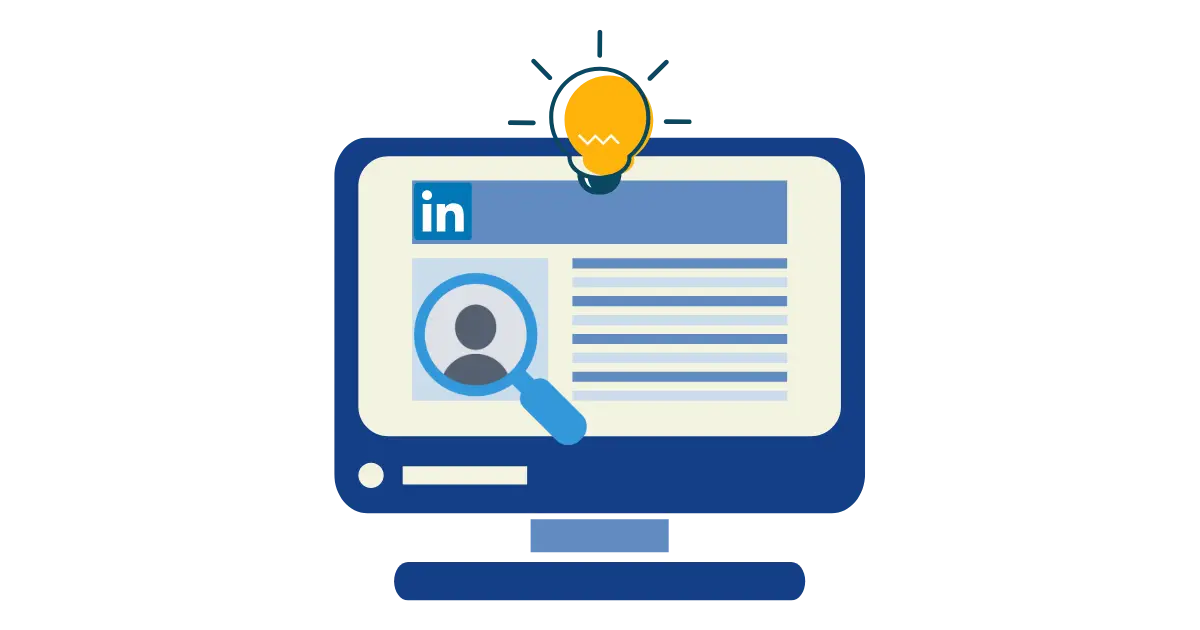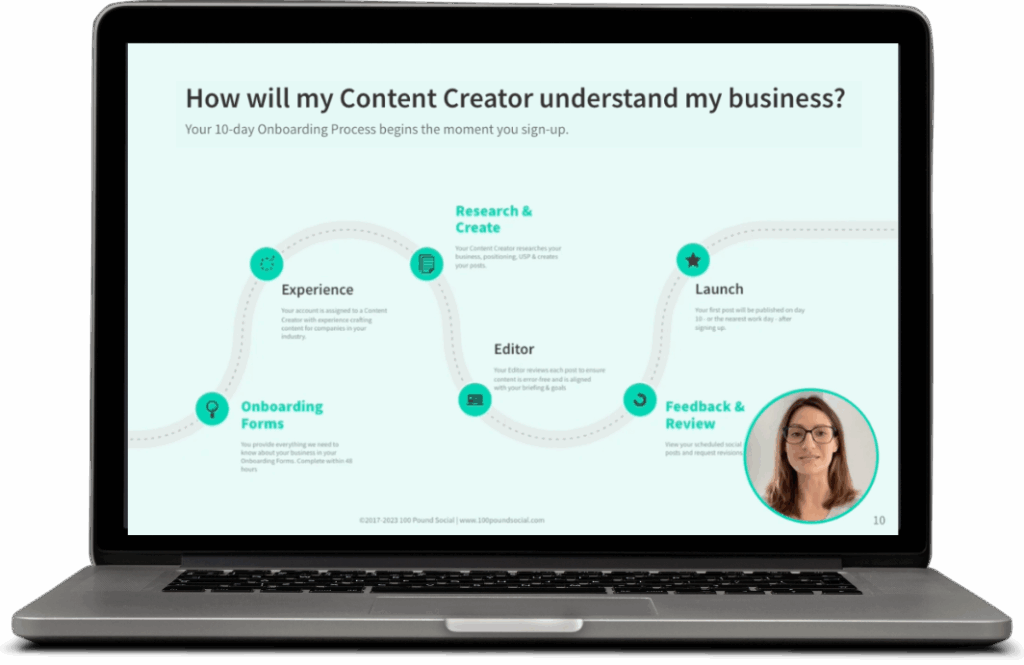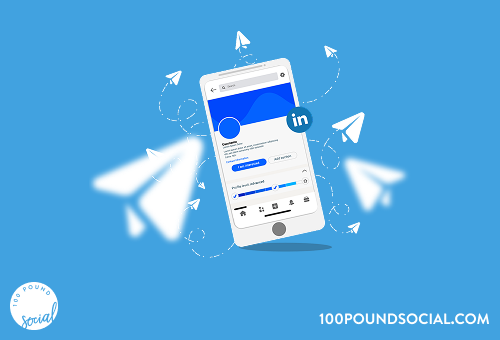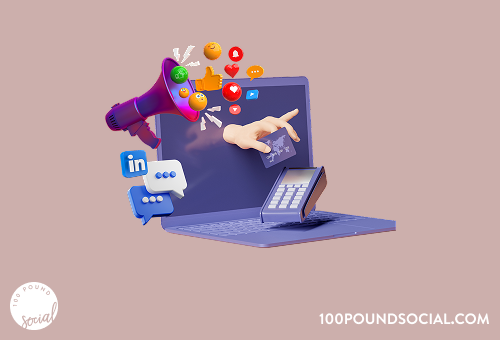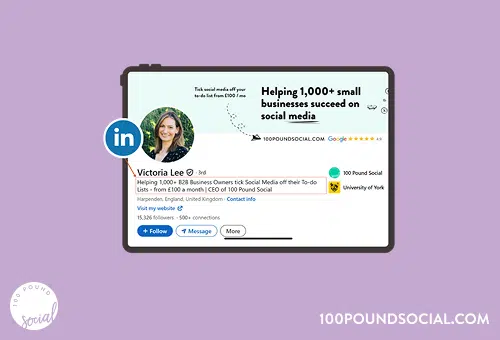LinkedIn has been the preferred platform for professionals to connect, collaborate, and grow their businesses since its launch in 2003. However, simply having a LinkedIn account is not enough.
Many B2B business owners post frequently and send connection requests without proper research, then they wonder how to get clients on LinkedIn and why they’re not generating leads.
The truth is, LinkedIn is constantly evolving, just like other social networks. In this article, we’ll discuss how to attract ideal clients on LinkedIn in 2026, along with the best tips and tricks to gain high-value clients.
What Does Lead Generation Mean on LinkedIn?
You should be aware of three essential aspects of how to get clients on LinkedIn right from the start:
- Identifying the market of your company (what is the main goal of your work);
- The identification of the decision-maker (who you must target and who might be attracted by your products);
- The right way to give the right offer (how to market your B2B services to a person who has shown an interest in your services).
LinkedIn sales can only be effective once the client is clear about what they are buying and the issues they can resolve by using your services.
To generate B2B sales on LinkedIn, you must present yourself to clients in a positive and professional way, highlighting both their pain points and your unique value. This is especially important for the B2B market.
Why Is LinkedIn a Great Platform for Business Owners?
LinkedIn is the largest business-oriented social network and a powerful platform for professionals. Take a look at the statistics below to see why LinkedIn is an excellent place to grow your B2B business:
- 2.7 million businesses post on LinkedIn each week.
- Optimised and active LinkedIn pages have five times more activity.
- 96 percent of B2B marketers use LinkedIn for organic promotion.
- Marketers see double the conversion rate from LinkedIn ads compared to other media.
- 77 percent of content marketers believe LinkedIn delivers the best organic results.
LinkedIn is a powerful platform where decision-makers and business leaders actively look to connect, collaborate, and grow. As a small B2B business owner, it gives you direct access to the people who matter most: potential clients, partners, and industry influencers. If you’re wondering how to get clients on LinkedIn, the key is to use it as a place to build genuine relationships, share your expertise, and position your business as a trusted solution provider in your niche.
What’s No Longer Effective on LinkedIn?
Let’s look at what is not working anymore on LinkedIn:
- Sending out mass connections without personalising them: They are usually ignored or rejected. Even worse, they can damage your reputation because you appear spammy.
- Ghosting and posting content strategies: Do you write and then leave? Engaging in a conversation without posting or sharing content is like going to an event, grabbing the DJ’s microphone, making an announcement, then walking out!
- Selling DMs: Cold pitching messages without any context or connection are more likely to be blocked rather than booked.
If this sounds like you, don’t worry! This is fixable.
Get 11 Creative LinkedIn Post Examples Here →
Insider Tips and Tactics to Find Clients on LinkedIn
1. Identify Your Ideal Client Profile (ICP)
One of the biggest mistakes small B2B business owners make on LinkedIn is promoting a broad or unrelated service instead of focusing on a clear, specific solution that directly meets their client’s needs.
Here are some examples of generic services:
- Ghostwriting
- SEO
- Graphic design
Instead, focus on your niche to become the most sought-after expert in a specific service.
A perfect client profile (ICP) includes the name of the person who will purchase your services and other factors such as:
- Industry (e.g., health, marketing, finance, etc.)
- Type of business (e.g., eCommerce, SaaS, B2B services, coaching business)
- Company size (e.g., 11–50 employees)
For instance, if you’re selling a marketing service, the person making the purchase will most likely be a Director, VP, or CMO. The decision-maker should not be a junior or associate marketing manager.
CMOs and VPs are ideal for small businesses with fewer than 50 employees, while the Director is usually the best contact for larger companies.
2. Make Your Profile More Current With A Mindset Focused On Clients
Your LinkedIn profile should serve as a marketing tool, not a job application. Too many business owners focus on listing their qualifications instead of addressing client needs. If you want to get clients on LinkedIn, start with a compelling headline that highlights the problem you solve.
For example, instead of “Certified Marketer with 10 Years’ Experience,” write “I help B2B Business Owners Generate Quality Leads Without Overspending.”
In your About section, start with questions that resonate with your audience, then introduce your services as the solution.
Finish with a clear call to action, such as:
“Want to solve your LinkedIn Lead Generation issues? Book a call now.”
3. Personalise Connection Requests and First Messages
Prospects are 181% more likely to accept your InMail if they already follow your company’s LinkedIn profile, according to LinkedIn’s study.
To keep your acceptance rates high, make sure your InMails and connection notes are personalised. If you’re learning how to use LinkedIn to get clients, even a brief mention of a recent post or a shared connection can make a big difference.
Write a 300-Character Hook for Your InMail or Connection Note
The headline of your InMail or note is your first impression, make it count. Keep messages empathetic, short, and relevant.
For personalisation, refer to:
- A LinkedIn group or mutual connection
- A comment the person shared on your post
- An insight you liked from their post
- A trigger event such as a job change or funding round
These help create common ground.
Example:
Hi [Name],
I came across your [post/recent update/comment] and really liked your perspective on [topic]. My team and I have been working on [specific areas or insight] that could be valuable for [their business or industry]. I’d love to connect and share ideas.
Send a Friendly Thank-You Message
After you’ve made contact, you have a chance to sell. While you might be tempted to leap immediately into the selling process, it’s just too early at this point.
Instead, be grateful and engage in an exchange. If you’re learning how to get clients on LinkedIn, remember that timing and approach are everything.
You could say something like, “Thank you for connecting, [Name]! I’ve been following [Company Name], and it looks like you’re doing some exciting work lately. What’s been the biggest focus or challenge for your team recently in [their area or industry]?”
Make sure the question is relevant and open-ended, not one that can be answered with a simple yes or no. You’re trying to stimulate conversations and build a stronger bond. This also means ensuring that the language is non-jargon, human, and conversational.
4. Creating Engaging Content
LinkedIn is the leading social platform for business owners and professionals who want to grow and connect. For small B2B businesses, it’s a powerful space to share your business journey, celebrate wins, and offer valuable insights that position you as a trusted expert in your industry, all while staying authentic and engaging. It’s important to approach the platform in a strategic way.
Before you begin posting, you must have a thorough knowledge of the algorithm to ensure that your posts are read by as many people as possible.
Techniques such as regularly posting, creating valuable content, and encouraging engagement can make an immense impact.
5. Sharing and Promoting Content
Regularly posting on LinkedIn is a great way to increase your visibility. It’s not only about quantity; it’s about quality as well. Each post should offer something valuable and unique for your readers.
Try experimenting with different types of posts to see what resonates most with your audience. What kind of content gets the best response from your ideal clients?
✅ Insightful list-style posts
✅ Long-form articles that share your expertise
✅ Short, conversational updates
✅ Client success stories or behind-the-scenes insights
The key is to keep your content valuable, relevant, and authentic to your brand voice.
6. Join the Right LinkedIn Groups
Many of your ideal clients are part of LinkedIn groups, but not all groups are equally active or valuable. The key is to find the ones where meaningful discussions are actually happening.
With a LinkedIn Sales Navigator account, you can identify groups where members are regularly posting, asking questions, and engaging. Focus on these, they’re where real networking opportunities happen.
When you contribute by answering questions or sharing thoughtful insights, you naturally position yourself as an expert and build trust with potential clients. You can also repurpose some of your best advice into LinkedIn posts to reach a wider audience beyond the group.
7. Add Details and Proof to Your About Section
According to Salesforce research, 81% of buyers make their decision before ever speaking to a sales representative. That means your LinkedIn profile often acts as your first “sales conversation.”
B2B buyers are naturally cautious, they want to work with people and companies they can trust. The more credibility you show, the more confident potential clients will feel about reaching out.
Make sure your About section highlights:
- Specific results or success stories that show real outcomes.
- Notable clients or partnerships (if appropriate to share).
- Professional milestones, certifications, or media mentions.
Also, build a strong network of meaningful connections, and don’t be shy about requesting recommendations from happy clients. Rememer that testimonials from real people carry huge weight and instantly boost your credibility on LinkedIn.
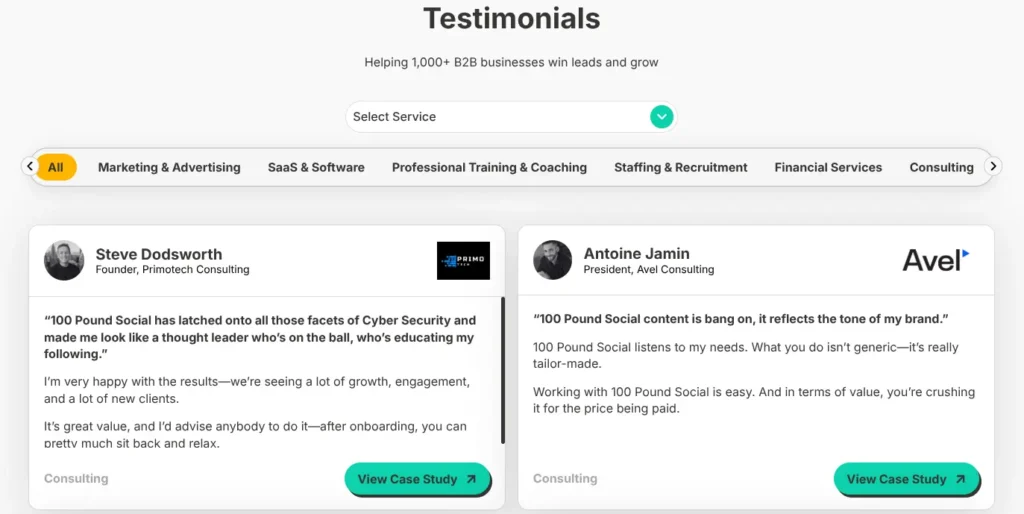
8. Use LinkedIn Company and Showcase Pages
If you run a business or marketing agency, setting up a LinkedIn Company Page is a great way to highlight your business, products, and services.
It is important to update your page regularly with interesting information, updates from your company, as well as client success stories.
You can take it a step further with a LinkedIn Showcase Page or Product Page to showcase the specific B2B services or products your company offers, allowing you to reach specific segments of clients more efficiently. These pages provide the most targeted and personalised experience for your intended audience.
Here’s how you can get the most value from your LinkedIn page for products:
- Consider the products, services, or initiatives you wish to showcase through Showcase Pages.
- Make sure you can customise the content and messaging on every Showcase Page to match the particular product or service being presented.
- Cross-promote Showcase Pages on the Company Page, other social media channels, and email newsletters.
- Continually monitor interaction and engagement with your Showcase Pages.
9. Use LinkedIn Ads When Organic Reach Isn’t Enough
While organic posts and social networking should be the mainstay of your LinkedIn strategy, pay-per-click advertisements are a highly effective way to supplement these efforts and generate more targeted leads for your company.
If you want to know how to use LinkedIn to get clients, LinkedIn’s advertising platform enables users to reach a specific audience based on factors such as job title, company size, industry, interests, and more.
Since LinkedIn users are in a professional environment, they are more receptive to relevant, professionally oriented ads compared with other social media platforms.
10. Present a Sales Offer That Solves Their Problems
Once you’ve developed trust with your LinkedIn contacts and are confident that you understand their requirements and issues, it’s time to present your sales pitch and demonstrate why they should invest in your products or services.
If you’re putting focus on how to get clients on LinkedIn, this is the stage where your efforts will start to pay off.
The key to a successful sales presentation is to show potential clients how your product will solve their specific problems and ease their concerns. Use the information you’ve gathered to strengthen your pitch and provide what your clients truly need.
First and foremost, focus on identifying your prospects’ business challenges and discover what keeps them awake at night.
11. Connect with Real Intent
Engagement can help you remain at the forefront of potential clients’ minds. If you respond to their blog posts and engage with them authentically, they will remember you.
You can achieve this by commenting on your ideal clients’ blog posts, not with generic phrases like “Great share!” but with genuine insights that add value to the conversation.
It shows that you are focused, active, attentive, and engaged—qualities that stand out far more than the majority of messages in their inboxes.
12. Upgrade to LinkedIn Sales Navigator

It’s definitely worth it.
Sales Navigator provides you with the features you need to create lead lists, such as:
- Filters at the account level (company headcount, funding status, hiring growth, and so on)
- Recognising “buying signals” (recent job changes, company growth, and so on)
- Advanced Boolean search to combine titles, such as: (“VP of Sales” OR “Sales Director”) AND SaaS NOT “consultant”
13. Leverage Your LinkedIn Page to Build Credibility
Your LinkedIn Company Page isn’t just a placeholder, it can be a hub for building trust with potential clients. If you want to get clients on LinkedIn, instead of treating it as a bulletin board for announcements, use it to showcase your expertise and thought leadership.
Here’s how to make your page work harder for your business:
- Share insights and advice relevant to your target audience, not just company news.
- Highlight client wins and case studies to demonstrate real-world results.
- Encourage your team to engage and share content, amplifying your reach.
- Link to resources or guides that provide value and draw visitors back to your website.
By focusing on credibility and value, your Company Page becomes more than a profile, it’s a tool that helps attract the right clients and positions your business as a trusted partner.
Let Us Take Care of Your LinkedIn Lead Generation, From £254/mo →
The Importance of Nurturing and Building Connections
Generating leads on LinkedIn is just the first step. If you really want to master how to get clients on LinkedIn real value comes from using the platform to identify the right potential clients and offer your B2B services effectively. When you spot an opportunity where your business can provide a solution, it’s crucial to approach it strategically; nurturing the relationship and guiding it toward a successful outcome.
Keep in Touch Regularly
After you’ve established connections, don’t let them go cold. Make an effort to contact your prospects once every two weeks, or more often. Keep in contact through:
- Congratulating leads for new promotions or jobs (LinkedIn simplifies this by notifying you whenever someone updates their profile information).
- Engaging with your leads in LinkedIn groups.
- Sending out information that your potential leads may find helpful.
- Commenting on your leads’ updates and articles.
Offer Help When Possible
You’ll need to earn trust to gain new clients on LinkedIn. One of the most effective ways to achieve this is by approaching interactions with a genuine intention to be helpful. Look for ways to support people and build their confidence without expecting any reward in return. Put selling aside and focus on building relationships first.
Make Useful Introductions
Want to help two people and make a positive impression on both? Introduce them.
It’s only advisable if you know both individuals well and have a genuine reason to make the introduction. When done appropriately, it can be an excellent way to build trust with your leads.
Be Patient And Wait For Results
The more professional relationships you build, the greater your chances of converting them into clients. However, relationship-building takes time and consistent effort. When developing your LinkedIn network, be open, share your knowledge, and create genuine connections.
You may lose potential clients if you rush the process and start pitching before earning their trust.
Final Thoughts
Getting ideal clients on LinkedIn in 2026 requires more than just sending connection requests or posting updates. It’s about building real relationships, demonstrating value, and creating trust through genuine engagement.
If you want to understand how to get clients on LinkedIn start by identifying your ideal client profile, optimising your LinkedIn presence, and sharing helpful content, you can attract decision-makers who truly need your expertise.
Keep your approach authentic, stay consistent with your interactions, and use LinkedIn’s advanced tools such as Company Pages and Sales Navigator, wisely.
Over time, your reputation will grow, your network will strengthen, and those genuine relationships will naturally turn into long-term business opportunities.
Next Steps
Getting ideal clients on LinkedIn isn’t about luck—it’s about consistency, strategy, and knowing how to position yourself in front of the right people. From building an optimised profile and creating meaningful connections to nurturing relationships and converting leads, every step requires focus and expertise.
Since 2017, we’ve helped over 1,000 business owners across diverse industries develop effective social media strategies that drive real client acquisition results.
Our clients consistently report increased turnover, growing social media followings that convert to business enquiries, and most importantly, signing new clients through their improved online presence.
Ready to transform your social media from a time drain into a client-generating asset?
Join a free 15-minute demo to discover how we can create expert content for your business from just £100 per month. Our comprehensive approach is focused on client attraction, content creation that resonates with potential clients, and performance optimisation—everything you need to turn your audit findings into sustainable business growth.
Book your demo today and let us show you how professional social media management can accelerate your success at attracting new clients, while giving you back valuable time to focus on serving your existing clients and growing your business.

